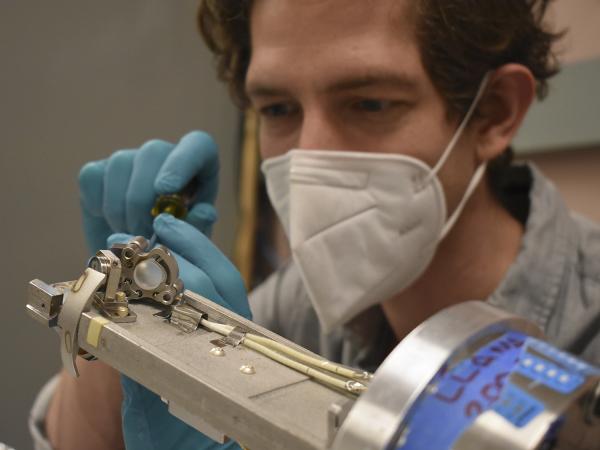
Aaron Rosenthal aligns the Lyman-alpha Measurement Apparatus in the lab with the help of a coordinate measuring machine, preparing it for operation on the DIII-D tokamak.
Photo: Julian Picard
MIT graduate student, Aaron Rosenthal, is developing a new camera diagnostic that will provide insight into neutral particles at the boundary of fusion devices.
April 26, 2021
A simple, longstanding imaging technology is helping to advance the latest fusion research. In a paper recently published in the American Institute of Physics (AIP) Review of Scientific Instruments MIT graduate student Aaron Rosenthal details how he and colleagues from Princeton Plasma Physics Laboratory (PPPL) are using a pinhole camera technique to answer questions about what is happening in the edge of hot plasmas confined in tokamaks, devices that use a doughnut-shaped geometry to contain fusion reactions.
A pinhole camera has no lens, but simply a hole that acts as an aperture, allowing light from outside to pass through and project an inverted image. Rosenthal and his teammates, aided by Plasma Science and Fusion Center (PSFC) engineers, have designed a new, absolutely calibrated pinhole camera system, based on a diagnostic originally installed on MIT’s Alcator C-Mod tokamak 20 years ago. They have attached the improved diagnostic to the DIII-D tokamak in San Diego in order to measure the brightness of Lyman-alpha light produced by hydrogen, an ultraviolet wavelength emitted at the boundary of fusion plasmas.
Lyman-alpha light is produced when neutral atoms of deuterium, a form of hydrogen commonly used to fuel today’s fusion experiments, interact with the plasma at the edges of the toroidal container in a region called “the pedestal.” As the neutral isotopes of hydrogen move towards the core of the plasma they ionize, fueling the plasma and affecting its behavior. By measuring the brightness of Lyman-alpha light the new camera system, known as the Lyman-alpha Measurement Apparatus (LLAMA), allows researchers to determine the neutral deuterium density and ionization rates so they can understand the influence of neutrals on fusion plasmas.
“We aren’t directly measuring neutrals,” says Rosenthal. “However, the amount of Lyman-alpha measured is closely related to the neutral density.”
Rosenthal notes that just as a column or statue depends on the pedestal it is built upon, what happens in the core of the plasma depends on what is happening in the edge pedestal region of the tokamak.
“Previously, we were unsure about what is a happening at the edge of the plasma. The LLAMA system provides improved measurements in that region. We will be better able to understand how neutrals affect the pedestal. ”
LLAMA introduces an improved means of measuring the neutral deuterium particles in this dynamic edge region at two locations: the inside of the torus (the “doughnut hole”) as well as the outside. By providing quantitative measurements of neutrals in two locations in the tokamak, LLAMA can identify when and how neutrals behave differently, as well as any asymmetric behavior. Using advanced filtering components that reduce contamination by neighboring line intensities, the new device also solves some engineering and measurement problems for Lyman-alpha light diagnostics.
To implement the LLAMA, PSFC engineers and researchers applied state-of-the-art alignment techniques using a coordinate measuring machine to allow high-resolution ex-vessel alignment of the diagnostic. The development of a calibration procedure in the ultraviolet wavelength, which has historically been a challenge, significantly advances the quantitative analysis of neutral particles in tokamaks. The decision to print multiple components of the camera system in Inconel, a non-magnetic metal, makes the device perfect for the extreme environments of magnetic confinement devices.
Rosenthal originally presented the paper as an invited talk at the High Temperature Plasma Diagnostics Conference (December 2020). His presentation was recognized with a prize for its adept and creative use of the video format, its clarity and content.
Before COVID restriction forced Rosenthal to work on his experiments virtually, he was making frequent trips to San Diego to install and study LLAMA. He is optimistic about making the device and its data the focus of his PhD thesis. The diagnostic has been working regularly for the past year, and Rosenthal notes that any physical changes to the set-up can be managed by PPPL colleagues on site.
“I’ll have plenty of data for my thesis,” he says, “ which is a good problem to have.”
This work was supported by the Department of Energy Office of Science, Office of Fusion Energy Sciences, using the DIII-D National Fusion Facility, a DOE Office of Science user facility.
Topics: Magnetic fusion energy, Alcator C-Mod tokamak, Plasma heating & current drive, Tokamak & stellarator collaborations